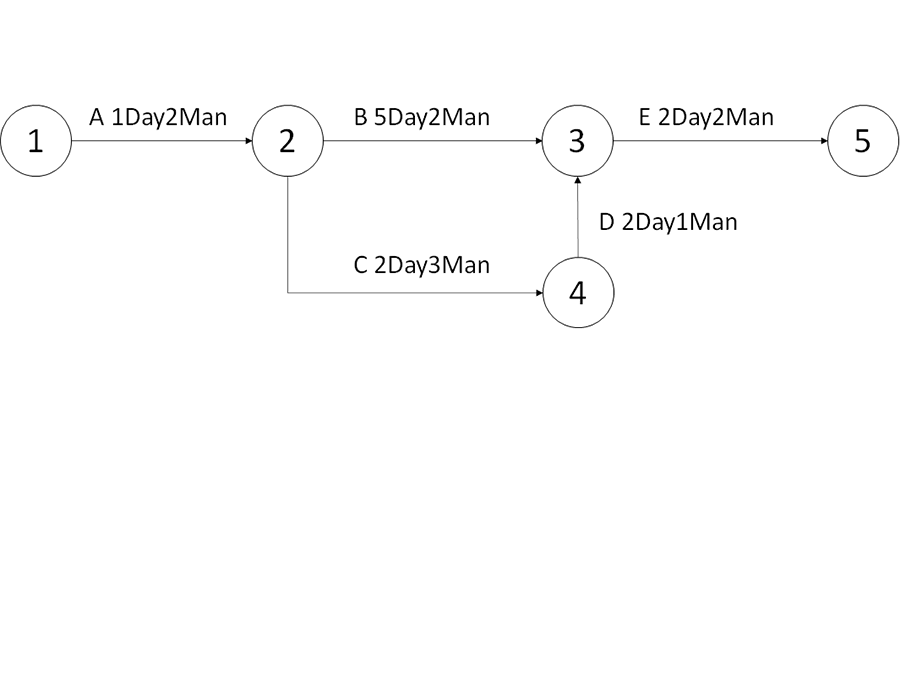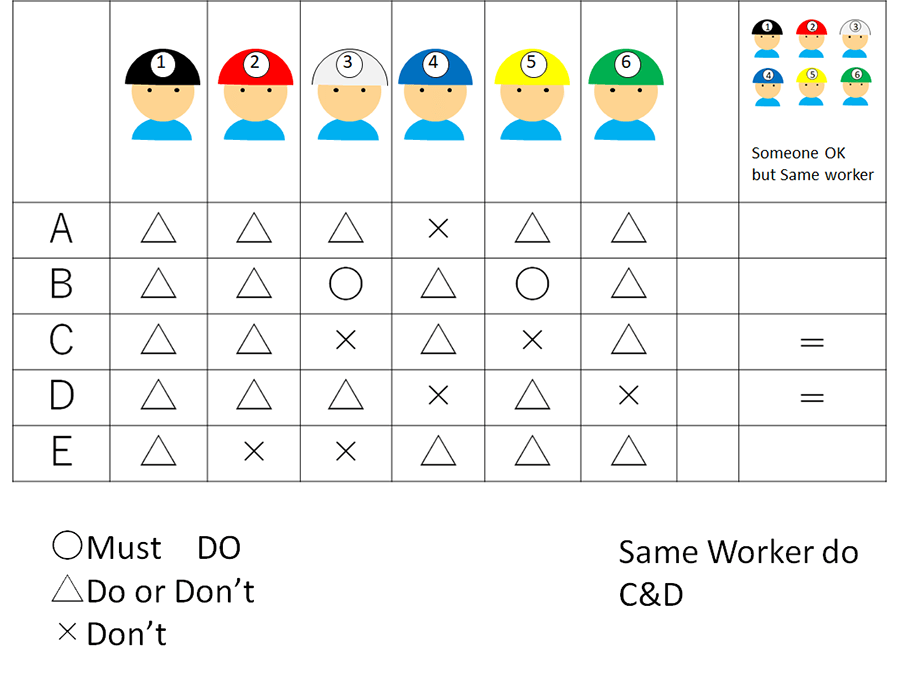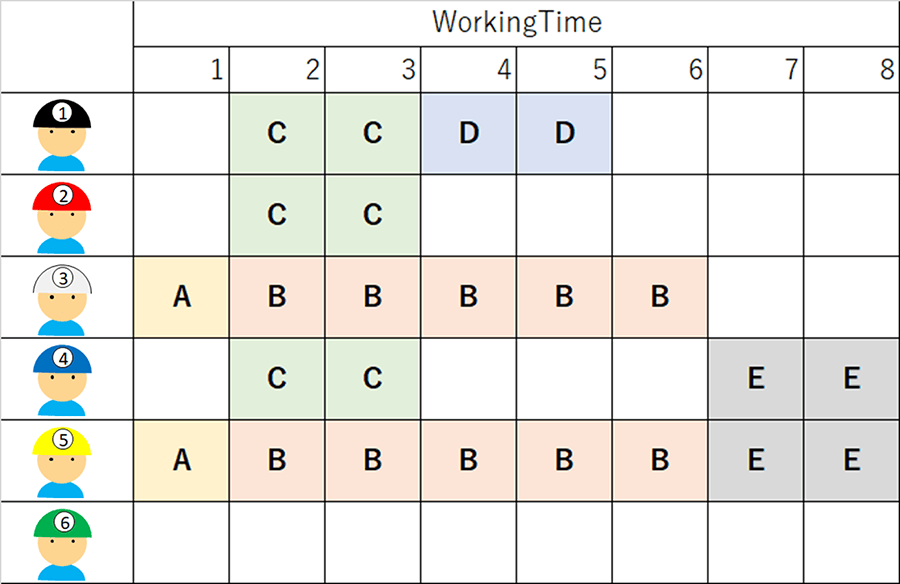Mar. 29, 2024
Making a Better Ever Processes! Virtual On-site Replication with Process SimulatorRisk Visualization and Process Optimization
At Toyota Motor Corporation's Frontier Research Center, as Toyota undergoes transformation into a mobility company, we have been addressing the challenges of labor shortage and aging workforce not only in the automotive industry but also in the construction industry. In collaboration with Obayashi Corporation (hereinafter referred to as "Obayashi"), our research partner, we have developed and evolved the process simulator "GEN-VIR®*1" as a solution*2-4. Furthermore, through interactions with workers at the Tomei Tamagawa Bridge renovation site*5, we have developed a strong desire to utilize GEN-VIR to prevent labor accidents more effectively and create more worker-friendly processes. In response to these challenges, we took on the challenge of developing technologies for "visualizing risks" and "optimizing processes" using GEN-VIR. Let us introduce the details of these developments along with team members Ogawa and Sugihara.
What is "Risk Visualization"?
―How did you go about visualizing risks to create a safe process?
- Ogawa
- One of the features of GEN-VIR, developed in collaboration with Obayashi, is the ability to replicate workers' actions in a virtual environment. We thought that if we could visualize the risks that workers would face in the virtual environment, similar to a role-playing game, the workers would be able to anticipate the risks they might encounter in the future and take measures to avoid or reduce those risks.
―I see. It seems challenging to predict risks based on workers' actions, especially when simulating the elimination of waste in work processes. What specific services have been developed?
- Ogawa
- Similar to the previous functionality, we utilized a game engine for the development. As for the specific service, we set up areas surrounding the sources of hazards, which are the root causes of accidents, and displayed keywords representing the occurrence of accidents above the workers' heads when they enter those areas. If multiple risks overlap, multiple keywords are displayed vertically. In addition, we can also display the severity of accidents each worker may face over time, as well as the cumulative time and frequency of exposure to each risk.
-

- Figure 1 Risk visualization function of GEN-VIR
―So, log data of their exposure to risks is created for each worker.
- Ogawa
- Yes. With this functionality, we can visualize the risks that all workers may face, which can be useful for individual risk management and mutual awareness of risks within a team.
―It seems useful for proactive risk prevention. How were the degrees of risk determined?
- Ogawa
- First, we set up areas for risk assessment for the objects that could become hazards. In Figure 1, "hole (high place)" in the work environment corresponds to this. Then, for each risk, Obayashi input parameters indicating the degree of risk based on their past experiences. When workers overlap with these areas and meet the conditions for risk occurrence, the risks are displayed. In the example in Figure 1, the risks are "tumbling" and "falling." Risks not only exist in the work environment but also in the tools and materials used. We also set up areas for risk assessment for those, inputting the types of risks, conditions for risk occurrence, and their degrees. In this way, we input the risks that may exist on the site within the scope of consideration.
-

- Figure 2 Risk configuration screen
Left: Area settings, Right: Parameter settings
- Video Simulation applying risk visualization to the mortar placement process
[Note: In consideration of the simulation load, some protective equipment is not being worn during the video. Also, in situations where work should be interrupted due to hazardous actions, work continues as normal in the virtual environment.]
―It's indeed a unique input process specific to GEN-VIR, where the work site and work processes are virtualized. How was this functionality utilized at the actual Tamagawa Bridge site?
- Ogawa
- When discussing the utilization of this functionality with Obayashi, it was decided to apply it to the "accident prevention activities for the mortar placement process*6" at the Tamagawa Bridge site. Before starting the work, all workers watched the video during the morning meeting to confirm the hazardous areas of the work. We received feedback from the workers, such as "It's easier to imagine than looking at paper or photos" and "It's easy to understand the dangerous areas from an aerial perspective."
-

- Figure 3 Accident prevention activities during the morning meeting
―Sharing the risks that oneself and colleagues may face in a few hours can enable mutual awareness and consideration. Thank you.
Creating Site-Specific Processes using Optimization Technology
―Now, let's hear from Sugihara, the developer, about the second challenge, "Process Optimization." First of all, what is optimization?
- Sugihara
- In our daily lives, we all create schedules for various tasks. When trying to finish a task quickly, it is natural to allocate more resources or use the latest equipment. However, optimization is about seeking solutions that minimize resources or time within the constraints of limited resources and work hours. Let me explain using a construction site as an example.
―What challenges are there at construction sites?
- Sugihara
- When creating a construction schedule, we usually refer to past cases and create schedules on a case-by-case basis. However, these schedules are not always efficient or well-coordinated in terms of manpower allocation. There is also a challenge in which work processes are not clearly defined, and the order of work relies on individual experience, making it difficult for the work manager to grasp the progress.
―What are the unique features of the optimization method developed this time?
- Sugihara
- Generally, there are methods that allocate machinery and workers to processes to minimize the duration of the project. In addition to that, the optimization method we developed can minimize the number of workers, minimize idle time, and create schedules that assign more work to specific workers. It also includes a functionality that assigns processes to workers based on their skills, which meets the needs of the actual work site.
―It's versatile in terms of optimization. Could you explain the mathematical methods used to derive the optimal solution and the technical details?
- Sugihara
- The mathematical optimization method used in this case is based on "linear programming" and the "scheduling problem*7." As conditions that the processes must satisfy, we provide the order of execution, the number of workers required for each process, and the number of days required, as shown in Figure 4(a). As a prerequisite condition for worker allocation, we consider the skills and team assignments of workers, as shown in Figure 4(b). We provide options such as "must work," "do not work," and "optional work" for each worker, considering the skills and team assignments. In the case of "optional work," we choose whether to "work" or "not work" to optimize the schedule. Moreover, it is inefficient for workers to move to a distant "location" every time the process changes, and there is a need for work managers to assign the same worker to a series of processes. Therefore, we can set the condition of "anyone can do it, but the same person should do it" as well. In Figure 4(b), the settings indicate that C and D should be performed by the same person.
-
 (a)
(a) -
 (b)
(b)
―You made the worker conditions clear for each process. Did you then solve the scheduling problem?
- Sugihara
- In the mathematical model we created, there are four separate optimization objectives: "minimizing project duration," "minimizing the number of workers," "minimizing idle time," and "prioritizing work allocation." These objectives can be specified individually or in combination. "Minimizing idle time" refers to minimizing the time when no one is working, and "prioritizing work allocation" refers to allocating more work time to workers who are expected to perform more tasks. Figure 5 shows an example of a schedule optimized for "minimizing project duration" with the conditions shown in Figure 4. In this example, worker 1 is assigned to processes C and D, and worker 2 is assigned to process C. Worker 6 is not assigned to any work.
-

- Figure 5 Schedule optimized for "minimizing project duration" with the conditions shown in Figure 4
―How is it being utilized at the actual site?
- Sugihara
- In the actual application of optimization, we listened to the requests of the construction contractors, created schedules by clarifying the conditions of the processes and workers, and assigned workers accordingly. In actual work, workers wore bibs with different colors for different roles, as shown in Figure 6. This made it clear which worker was responsible for which task and made it easier for the site supervisor to manage the work. Please refer to the Obayashi Corporation press release for more details (Japanese only).
-

- Figure 6 Utilization of bibs at the site
Outlook for the Future
―Finally, please tell us about the outlook for the future.
- Sugihara
- The two technological developments we introduced today are expected to demonstrate their true capabilities in pre-implementation discussions to create better processes for the site. We will continue to discuss and develop risk visualization and process optimization with the construction site staff at Obayashi Corporation, aiming to make work easier for many workers. We also believe that these technologies have the potential to be applied in various other fields, so we would like to evolve GEN-VIR while utilizing it in different sites.
-

- Figure 7 Project team photo
Ogawa: Second from the left in the top row, Sugihara: Third from the left in the top row
References
| *1 | A process simulator developed jointly by Toyota Motor Corporation and Obayashi Corporation. It is based on Toyota's on-site replication and aims to replicate work processes in a virtual environment, with the goal of improving human-centered processes. GEN-VIR is a coined term combining "GEN" (the Japanese reading for "on-site") and the first three letters of "virtual," creating a wordplay. It is a registered trademark of Toyota Motor Corporation. |
|---|---|
| *2 | Using Simulation to Improve Conditions for Construction Workers |
| *3 | Developing a Construction Simulator That Can Be Used by Anyone for Any Process |
| *4 | Toyota Times: Does Kaizen Work on Massive Construction Projects? |
| *5 | Tomei Expressway Renewal Work (Tomei Expressway Tamagawa Bridge)
|
| *6 | Work involving pouring mortar (a construction material made by mixing sand, cement, and water) into molds. |
| *7 | The scheduling problem refers to determining the start time of each task in a predetermined order with known equipment requirements, aiming to minimize the duration of the final task. |
Authors
Yuta Ogawa
Joined in 2017. Previously involved in research and development of gasoline engines and energy simulators related to electric vehicles. Engaged in the current project since 2023, responsible for the design and evaluation of GEN-VIR.
Hisayoshi Sugihara
Joined in 1991. Involved in the design of manufacturing facilities. After transferring to the robot development department, responsible for the overall development of element technologies such as bipedal control, sensors, and image and voice recognition. Since 2022, responsible for process optimization.
Contact Information (about this article)
- Frontier Research Center
- frc_pr@mail.toyota.co.jp






